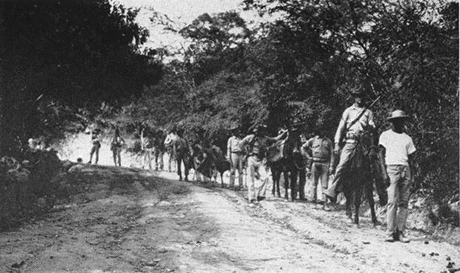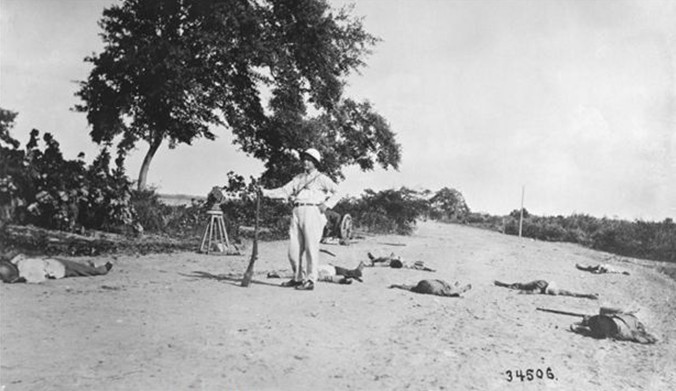President Andrew Johnson had suggested in 1868 that the United States annex the entire island of Hispaniola, which included the modern-day nations of Haiti and the Dominican Republic. His intention was to defend U.S. defensive and economic interests in the West Indies. Meanwhile, France retained strong economic and diplomatic ties with Haiti following the 1824 Franco-Haitian agreement: France agreed to recognize Haitian independence, but only if Haiti paid a large indemnity to cover the cost of French infrastructure.
Study the information on the tabs below to learn why Taft intervened in Haiti--and how well his strategy worked.
Token Independence
Germany Interests
A Failure of Diplomacy

A Haitian guide is leading the party.
For most of its history, French colonialism had kept Haiti in a constant state of debt. Even after granting the island independence, France retained control of Haiti's economy. This certainly was not a situation that the U.S. encouraged--especially after the Panama Canal created a need for regional naval ports throughout Latin America and the Caribbean. In any case, the French, Spanish and English were no longer a major problem for the U.S. since they generally respected the Monroe Doctrine restrictions regarding trade in the region. However, European powers were clearly never very happy with the arrangement and found subtle ways to resist. For instance, the French applied pressure to the Haitian government to prevent the U.S. from acquiring part of Haiti's northern coast to be used as a naval base.
The real danger for U.S. interests, though, was the rising German commercial influence in the region and the fact that Germany openly disputed American domination of the region. Only a few hundred Germans lived in Haiti, yet they controlled about 80% of national exports. Also, the Hamburg-Amerika maritime service had largely infiltrated the Caribbean, and in many locations they held a dominant position in the commercial transport market. Meanwhile, the Germans were emerging as a major trading competitor of the U.S. in many regions of the world.

Taft's administration was particularly worried about Germany's military presence in the region. During an incident in 1897, a Haitian boat had been sunk by its captain to avoid seizure by a German naval ship. Taft was informed in 1909 that Germany intended to establish a coaling station to serve the German naval fleet--in the very same port location that the U.S. had tried to lease from the Haitian government.

U.S. Marine machine gun fire - Oct 11, 1915
In 1910, Taft presented Haiti a substantial loan to reduce its foreign debt, but the country was far too unstable, regardless of state finances. Furthermore, by 1912 the increasingly militant German presence in the region seemed to warrant a U.S. response. After all, this was the first major threat posed by any European or Asian nation to Roosevelt's Monroe Doctrine Corollary. Taft and Knox began preparing the Marines for another intervention that would occur in 1915 during Woodrow Wilson's presidency. In another setback for Taft's dollar diplomacy, the U.S. would again find itself encumbered long-term in a regional military occupation--one that would extend until 1934.
Question
Did Haiti's leaders have good job security?
